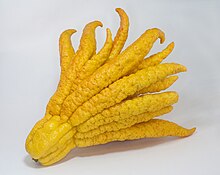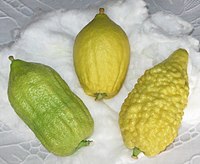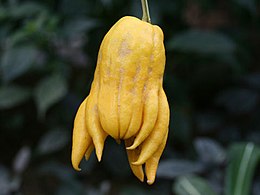Buddha's hand
This article needs additional citations for verification. (February 2020) |
| Fingered citron | |
|---|---|

| |
| Buddha's hand fruit, "open hand" appearance when ripe | |
| Scientific classification | |
| Kingdom: | Plantae |
| (unranked): | Angiosperms |
| (unranked): | |
| (unranked): | |
| Order: | |
| Family: | |
| Genus: | |
| Species: | C. medica |
| Variety: | C. m. var. sarcodactylis
|
Trinomial name
| |
| Citrus medica var. sarcodactylis (Hoola van Nooten) Swingle
| |
| Citron varieties |
|---|
 |
| Acidic-pulp varieties |
| Non-acidic varieties |
| Pulpless varieties |
| Citron hybrids |
| Related articles |
| Buddha's hand | |
|---|---|
| Chinese name | |
Hanyu Pinyin | fóshǒugān |
| Transcriptions | |
|---|---|
| Revised Romanization | bulsugam |
| Transcriptions | |
|---|---|
| Romanization | busshukan |
Citrus medica var. sarcodactylis, or the fingered citron, is a
The different cultivars and variations of this citron variety form a gradient from "open-hand" types with outward-splayed segments to "closed-hand" types, in which the fingers are kept together. There are also half-fingered fruits, in which the basal side is united and the apical side fingered. The origin of this kind of citron is commonly traced back to South or East Asia, probably northeastern India or China, where most domesticated citrus fruits originate.[1]
Description
Citrus medica var. sarcodactylis
The plant is sensitive to frost, as well as intense heat and drought. It grows best in a temperate climate. Trees can be grown from cuttings taken from branches two to four years old. It is very commonly grafted onto sufficient rootstock.
Uses
Perfumery
Buddha's hand fruit is very fragrant and is used predominantly in China and Japan for perfuming rooms and personal items such as clothing.
Religious
The fruit may be given as a
The question of whether a Buddha's hand is acceptable for use as an etrog on Sukkot was addressed by Rabbi Abdallah Somekh and his disciple, Rabbi Yosef Hayyim, both of Baghdad. The former was inclined to permit it, whereas the latter maintained that one may not use a variety of etrog in the absence of a positive tradition of its having been used.[5]
Ornamental
The fingered citron is cultivated as an
Food and medicine
Unlike other citrus fruits, most varieties of the Buddha's hand fruit contain no pulp or juice. Though esteemed chiefly for its "exquisite form and aroma", the Buddha's hand fruit can also be eaten (often as a
Gallery
-
A fingered citron byVolckamer
-
Fingered citron by Wellcome Trust
-
Huge fruit breaking bearing twig
-
Buddha's hand citron in Val Rahmeh botanical garden
-
Semi-fingered and closed
-
Closed fingers
-
Side view
-
A fingered citron
-
Semi-closed fingers
-
Semi dwarf fingered citron (green)
-
With open fingers
-
Cross section in aVariety etrogcitron, and in fingered citron
See also
References
- Karp, David (Winter 1998). "Buddha's Hand Citron". Flavor and Fortune. 5 (4). Kings Park, NY: Institute for the Advancement of the Science and Art of Chinese Cuisine: 5–6. Archived from the originalon 2011-06-06. Retrieved 2010-04-20.
- Storrs, CT: University of Connecticut, Department of Ecology & Evolutionary Biology, Plant Growth Facilities. Retrieved 2010-04-20.
- ^ a b "Buddha's hand citron". Catalog of the Citrus Variety Collection. Riverside, CA: University of California, Riverside, Department of Botany and Plant Sciences, Citrus Experiment Station. Retrieved 2010-04-20.
- ^ "Buddhas Hand". Melissa's Produce.
- ^ "Responsa Zivhei Tzedek, Orah Hayim §37".
- ISBN 978-3-031-25775-9.
External links
 Media related to Buddha's hand at Wikimedia Commons
Media related to Buddha's hand at Wikimedia Commons- Pictures













